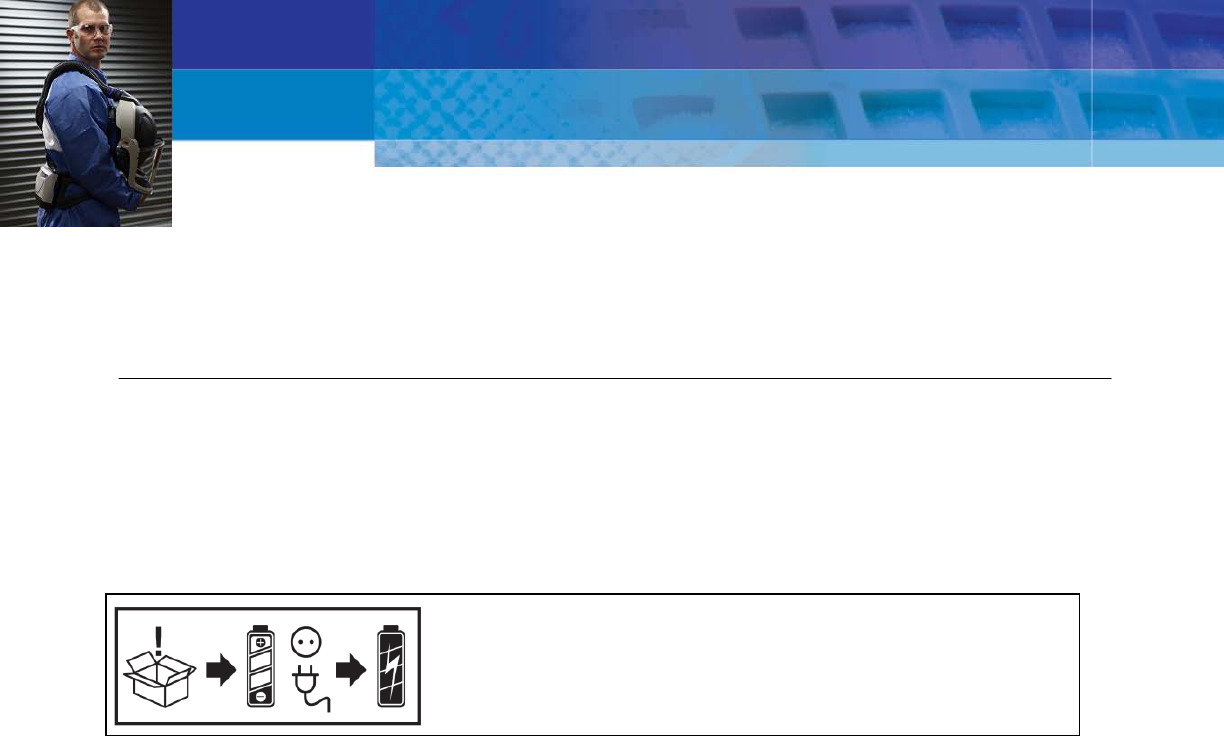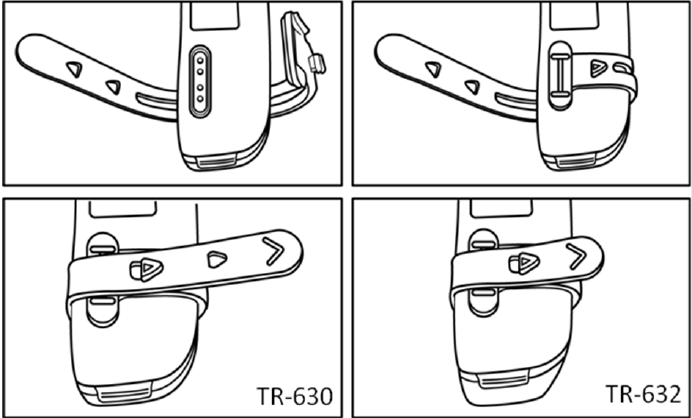
TECHNICAL DATA BULLETIN #223
BATTERY MAINTENANCE FOR 3M™ VERSAFLO™ RESPIRATOR SYSTEMS
Consult the TR-600 or TR-300 PAPR User Instructions for general system operation.
Published: June 2014
Rev: 1 Replaces all previously published guides on this topic until superseded.
The following Technical Data Bulleting is for reference purposes only. Before using the TR-300 or TR-600
PAPR, all users must read and understand the appropriate product’s User Instructions. If you have
questions, consult your supervisor or call 3M Technical Service at 1-800-243-4630 (USA) or 1-800-267-4414
(Canada).
Battery should be charged immediately and fully upon receipt.
Battery should be fully recharged at least every 9-12 months.
General Recommendations
• Always read and follow the User Instructions that accompany the battery pack and charger.
• Use only 3M TR-600 chargers to charge TR-600 battery packs.
• Use only 3M TR-300 chargers to charge TR-300 battery packs.
• Battery pack capacity may be reduced if stored or used in high temperature environments or near
radiant heat sources.
• 3M™ Versaflo™ PAPR battery packs can be charged any time during the discharge cycle. Battery
memory (also known as voltage depression) is not a significant factor.
• Battery packs can be cleaned with a damp cloth and mild detergents. Solvents and strong detergents
may damage the battery pack case.
• Do not charge battery packs in an enclosed cabinet without ventilation. Do not stack batteries together
or on top of charger when charging. Heat naturally generated during charging must be allowed to
dissipate or it may damage battery pack cells.
• 3M™ Versaflo™ battery pack capacity can be checked directly with the status indicator on the battery
pack.
• Do not attempt to discharge the battery pack by short-circuiting the terminal pads.
• For long-term storage, disconnect battery pack from the motor/blower unit. See storage
recommendations in this document.
Technical Data Bulletin #223

TDB#223 Battery Maintenance for 3M™ Versaflo™ PAPRs
Page 2 of 8
PAPR
Battery Packs
Charger
TR-300
TR-330 Standard Capacity
TR-340 cradle
TR-341 - Single station, TR-344 - 4-station
TR-332 High Capacity
TR-600
TR-630 Standard Capacity
TR-640 cradle
TR-641 - Single station, TR-644 - 4-station
TR-632 High Capacity
Operational Recommendations
3M™ Versaflo™ lithium-ion (Li-ion) battery packs offer quick charging (100% typically in less than 3.5
hours), light weight and compact size. In addition to the general recommendations above, the following
operational recommendations should be followed:
Charging
Initial Use:
The 3M™ Versaflo™ battery packs do not require a learn cycle to calibrate or re-calibrate the
battery pack charge indicator. However, it may take up to three complete charge/discharge cycles for the battery
to reach its maximum capacity and claimed run times. Typically, the difference between the capacity of a new
battery as received and the maximum capacity is only a few percent, and will likely be unnoticeable to the user.
Other than charging the battery upon receipt, no special conditioning is required or recommended prior to initial
use.
Operational Use
TR-300 battery packs have an operating temperature of 23° F (-5° C) to 129° F (54° C).
TR-600 battery packs have an operating temperature of 14° F (-10° C) to 129° F (54° C).
Operating temperature:
Do not expose battery pack to temperatures above 129º F (54º C). Run time will be reduced when used at
temperature extremes. The 3M™ Versaflo™ PAPR battery alarm will activate if battery pack temperature
reaches 130º F (55º C) while the motor blower is in use. If this happens immediately leave the contaminated
area. The motor blower will immediately shut down when the internal battery temperature reaches 140º F (60º
C).
Charging temperature:
The internal battery pack temperature must be between 32º F (0º C) to 104º F (40º C)
when charging – do not charge outside of this range. Optimal internal battery charging temperature is 68º F to
77º F (20º C to 25º C). Outside of the overall temperature range, the charger will indicate a temperature fault
(slow flash amber LED error) and will not charge. Charging will start when battery pack temperature is within
range. Repeated charging outside the optimal temperature range will reduce battery pack run time and cycle
life. If a battery feels hot, let it cool for 1/2 hour before charging. If the charger senses the battery is too hot it
will go into a standby mode until the battery has cooled.
Not intrinsically safe
: The TR-300 and TR-600 PAPR respirator systems and battery pack chargers are not
rated for intrinsic safety/hazardous location use. Use the PAPR system and charge battery packs only in non-
hazardous locations.
Run time:
The run times for each 3M™ Versaflo™ PAPR system will vary for each configuration and is
dependent on headgear, filter/cartridge, selected airflow, filter loading, battery selected, battery condition, and
environmental conditions. For TR-600, refer to the TR-600 System Run Times Guide for additional
information. For TR-300, refer to the TR-300 PAPR User Instructions.
Service life: 3M™ Versaflo™ battery packs provide approximately 250 full capacity charge/discharge cycles
while maintaining 80% of the original charge capacity over the course of the first year of service when used
under recommended conditions. See Figure 1. If the battery is used infrequently over an extended period of
time, the approximate 250 full cycle equivalents may not be reached due to natural degradation of the battery’s
chemistry. Normal use of the battery and natural aging of battery cells will gradually decrease the battery’s
available capacity, which results in decrease in run time. Batteries may continue to be used as they age, as long

TDB#223 Battery Maintenance for 3M™ Versaflo™ PAPRs
Page 3 of 8
as battery run time is sufficient to power the PAPR for sufficient time to safely perform the given task and exit
the contaminated area. Consider replacing the battery pack when maximum charging capacity drops below 80%
as shown on the battery pack charge indicator.
1 cycle = discharge of 90% of battery pack capacity. Partial cycles are counted and added up until 90% is
reached.
For example: User runs battery pack for 2 hours and depletes it 20% of capacity. User
does this for 4 more days, recharging the battery pack at the end of each day (total of 5
days use). 1 cycle has occurred at the end of the 5
th
day. (20% discharge/day) X (5 days
use) = greater than 90% discharge. The battery will register 1 charge/discharge cycle
after 5 days.
The number of bars illuminated indicates approximate battery pack charge status remaining: 5 bars = 80-100%,
4 bars = 60-80%, 3 bars = 40-60%, 2 bars = 20-40%, 1 bar = < 20%, 1 bar flashing = < 10%. The charge status
indicator is based on the original charge capacity. It does not recalibrate as the battery ages, and the number of
bars illuminated with a fully charged battery will decrease as the battery naturally loses capacity. This is a
safety feature so that throughout the life of the battery the number of charge status bars lit consistently indicates
approximate run time remaining (with a given system setup and filter loading). When the low battery alarm
sounds, users must immediately exit the hazardous area and replace the battery.
For example: An older battery pack or one that has been exposed to temperature
extremes is showing less than 5 bars after the charger indicates the battery is fully
charged (i.e. after a charge cycle, only 4 bars light indicating 60-80% of original
capacity is available).
Figure 1 – Remaining battery cell capacity decreases with cycle number.
No serviceable parts:
There are no user serviceable parts inside either the battery pack case or the chargers. Do
not attempt to open; doing so may expose you to hazardous voltage.
Transportation:
Consult a transportation specialist for any requirements or limitations prior to transporting
lithium-ion battery packs. 3M™ Versaflo™ battery packs are shipped compliant with UN 38.3.

TDB#223 Battery Maintenance for 3M™ Versaflo™ PAPRs
Page 4 of 8
Cleaning
Follow the hygiene practices established by your employer for cleaning the specific contaminants to which the
system has been exposed. Solvents should not be used to clean the battery pack or battery charger. Liquid
solvents may chemically weaken the plastic. Many water based cleaners have been tested on the battery pack
housing using a wipe test and found to not degrade the plastic. More information on the cleaners tested, the test
procedure, and the results can be found in 3M Technical Data Bulleting #222 – Cleaning and Maintenance of
the TR-600. The TR-300 and TR-600 batteries use similar blends of plastic for the housing.
The smooth finish on the TR-300 and TR-600 batteries make them conducive to being effectively cleaned by
simply wiping them down with a damp cloth. Wipe the housing of the battery pack with a soft cloth dipped in
mild cleaning solution or a pre-wetted cleaning wipe, such as the 3M™ 504 Respirator Cleaning Wipes. Liquid
should not be allowed to remain on the batteries gold plated terminals, and the terminals should be dried after
cleaning. If the terminals are dirty or corroded and wiping with a cleaning cloth is not working, using a pencil
eraser to gently clean the terminals may be effective.
TR-300 Batteries: Do not submerge TR-300 batteries and do not attempt to clean TR-300 batteries in a
respirator washer.
TR-600 Batteries: The TR-600 batteries are sealed and designed for temporary immersion for cleaning. The
TR-600 batteries are rated to IP67 under the Ingress Protection standard (IEC 60529). With the cleaning and
storage plug installed (Figure 2) from the TR-653 cleaning and storage kit, the TR-600 batteries may be
immersed for cleaning. There are two locking loops on the battery cleaning cover. The smaller loop position is
for use with the Versaflo TR-630 standard capacity battery, the large loop position is for use with the Versaflo
TR-632 high capacity battery. Do not immerse the battery in greater than 2 feet (0.6 meters) of water, or for
longer than 2 minutes. Dry the battery after cleaning, paying particular attention to drying battery terminals. If
water is found between the battery and the cleaning cover after immersion, inspect the cleaning cover for
damage. If the cover is damaged or is no longer sealing correctly, discard the cleaning cover and replace. Do
not attempt to clean battery in respirator washer. Do no submerge TR-300 batteries.
Figure 2 – Installation of battery cleaning cover.

TDB#223 Battery Maintenance for 3M™ Versaflo™ PAPRs
Page 5 of 8
Storage
Battery packs should be charged immediately and fully upon receipt. The battery should be fully recharged after
each use and at least every 9-12 months.
Recommended storage conditions:
-22º F (-30º C) to 122º F (50º C); Optimal: 59º F (15º C). Dry conditions,
relative humidity < 85%.
The battery pack may remain connected to the charger for an extended period of time. However, for long-term
storage, to maximize battery pack life, 3M recommends storing the battery pack off the charger at
approximately 40% charge as shown by the battery pack charge indicator. The battery pack should be
disconnected from the motor/blower during storage.
Shelf life:
The battery packs have a one (1) year suggested shelf life from the date of manufacture when stored
in original packaging and recommended storage conditions. The LOT code is embossed on each battery pack,
and can be used to determine the date of manufacture. See Figure 3 for locating the LOT code. The LOT code is
formatted as (YYWWX); YY = year of manufacture; WW = weak of year.
For Example: Your battery has a LOT code of 14231. This means that your
battery was manufactured on 23
rd
week of 2014, or the week of June 8
th
, 2014.
Figure 3 – Location of lot code.
Self-discharge:
During storage (anytime not is use or being charged) batteries will naturally lose a percentage of
their charge (remaining capacity), known as self-discharge. The self-discharge rate is mainly governed by the
battery chemistry itself and storage conditions, but may also be affected by on-board circuitry. The 3M™
Versaflo™ battery packs have a self-discharge rate between approximately 2.5% and 4% per month depending
on the size of the battery pack. Smaller battery packs have a higher self-discharge rate than larger packs.
Batteries stored at higher temperatures have a higher self-discharge rate than batteries stored at lower
temperatures.
Hibernation:
The TR-300 and TR-600 battery packs are controlled and monitored by onboard electronics. This
circuit board uses a small amount of power to continuously monitor the battery and keeps it ready to
communicate with the PAPR or the battery charger. This small amount of power draw contributes to the self-
discharge rate of the battery. When the battery is low on charge, the circuit board will automatically shut itself
down to conserve power. This is referred to as hibernation. While hibernating, the charge status indicator on the
battery pack will not light, the battery will not power the PAPR, and the battery will not communicate with the
battery charger to initiate a charge cycle. The TR-600 battery chargers and certain TR-300 chargers are
equipped with a ‘wake-up’ feature that will provide a small voltage into the battery when it is first placed on the
charger. This wake-up pulse may be enough to bring a battery out of hibernation, thus allowing the charge cycle
to continue as normal. TR-300 battery chargers labeled ‘Rev. C’ and later and all TR-600 battery chargers
include the wake-up feature.
Deep-discharge: When a battery is discharged past a certain point, it can go into a ‘deep-discharge’ state.
During deep-discharge the battery cell can physically break down and become permanently and progressively

TDB#223 Battery Maintenance for 3M™ Versaflo™ PAPRs
Page 6 of 8
damaged. The deeper the discharge and the longer allowed to remained discharged, the more damaged the
battery will become. One phenomenon that can occur during deep-discharge is the tendency of the Li-ion
electrolyte to crystallize and adhere on the battery cell’s anode (negative terminal side), which reduces the
amount of free electrolyte capable to do work. Cycling the battery three or more times may help break-up the
crystallized electrolyte, thereby restoring capacity to the battery. However, this procedure is only occasionally
and partially effective.
• Prolonged storage – The TR-300 and TR-600 battery packs have a one (1) year suggested shelf life from the
date of manufacture when stored in original packaging and recommended storage conditions. While in
storage, the battery will continuously lose charge through self-discharge. If stored off the charger for an
excessive amount of time, the battery may self-discharge into a deep-discharge state. Batteries should be
charged immediately and fully upon receipt, and at least every 9-12 months.
Causes of Deep-discharge:
• Storage after use without charging – Batteries that have been fully or partially discharged will go into a
deep-discharge state due to self-discharge faster than a fully charged battery. Depending on how much
capacity is remaining on the battery, it may start going into a deep-discharge state in only a few days.
Because of this, batteries should be charged soon after each use.
• Forced overuse – Forced overuse is caused by turning the PAPR back on (without charging or changing the
battery) after the PAPR has automatically shut down due to low battery charge. The automatic shut down
due to low battery level occurs approximately 10-15 minutes after the PAPR’s low battery alarm sounds.
The automatic shut down point is set to preserve a small amount of charge capacity to prevent the battery
from going into a deep-discharge state. Forcing the PAPR to turn back on after automatic shut down may
cause the battery to go into a deep-discharge state in a very quickly.
Disposal
To properly dispose of the 3M™ Battery Packs follow local solid waste disposal regulations or call the RBRC
Battery Recycling Information Help line at 1-800-822-8837. The charger contains electronic components.
Dispose of according to local and government regulations.
TROUBLESHOOTING
Use the table below to help identify possible causes and corrective actions for problems you may experience.
Consult the TR-600 trouble shooting guide or contact 3M Technical Service to help identify possible causes
and corrective actions for any other problems you may experience.
Problem
Probable Cause
Corrective Action
Charger Power on indicator not
lit
AC power cord not connected to
wall outlet
Power cord not connected to
charger
Power supply not functioning
Cradle not seated properly in
multi-base
Battery has gone into hibernation
Check all power supply
connections
Check all power supply
connections
Switch to alternate power source
Remove and reseat cradle
TR-300 batteries – place on TR-
340 charging cradle Rev. C or
later.
TR-600 batteries – place on any
TR-640 charging cradle.
Battery will not go into charge
mode
Battery is fully charged
Battery not seated properly in
cradle
Battery or charger contacts are
No action necessary
Remove battery and reseat in
cradle
Clean and dry electrical contacts

TDB#223 Battery Maintenance for 3M™ Versaflo™ PAPRs
Page 7 of 8
dirty
Defective battery
Defective charger
Battery too hot or too cold
Battery/charger electrical contacts
are dirty
Battery has been exposed to water
beyond acceptable limits
Replace battery
Replace charger
Allow battery to return to room
temperature
Clean contacts and reseat in cradle
Cease using; replace battery and
remove from further service.
Battery becomes hot during
charging (>113°F, 45°C)
Defective battery
Remove battery from charger
immediately. Replace battery
and remove from further
service.
Error message (amber and green
light flashing)
Fault condition identified
Defective battery
Remove battery from cradle and
reinsert. Reseat cradle in
docking station if used.
Contact 3M Warranty and
Repair.
Replace battery and remove from
further service.
Charger indicates complete
charge, but battery pack on-
board charge status gauge
shows less than 5 bars.
Battery pack has reduced capacity
due to age, damage, or use
outside of recommendation in
these User Instructions.
Remove battery pack from service
and replace with new pack.
Battery pack does not fully
charge within the stated
charge times.
Charging location or battery
excessively hot or cold.
Charge battery in room
temperature location. Allow
battery to cool to room
temperature prior to charging.
TR-644N charger does not power
up when plugged in.
Blown fuse in charger
Replace fuse 250V; 15A
Battery pack does not power
motor blower.
Battery contact on battery pack or
blower is damaged
Contaminant on battery or blower
contacts
Battery is completely discharged
(no charge)
Battery internal safety circuit
tripped during cleaning
Battery internal safety circuit
tripped during charging
Check that the battery contact is
not bent or broken
Ensure battery contacts are clean
Fully charge the battery pack /
contact 3M Warranty and
Repair
Replace battery. Do not exceed
battery cleaning guidelines.
Segregate battery and charger.
Contact 3M Warrant and
Repair.

TDB#223 Battery Maintenance for 3M™ Versaflo™ PAPRs
Page 8 of 8
FOR MORE INFORMATION ON 3M PRODUCTS
United States Canada
For other 3M products: For other 3M products:
1-800-3M-HELPS or 1-651-737-6501 1-800-364-3577
www.3M.com/PPESafety www.3m.com/CA/PPESafety
3M Personal Safety Division
3M Center, Building 0235-02-W-70
St. Paul, MN 55144-1000
3M™ and Versaflo™ are registered trademarks of the 3M Company, and used under license by 3M Canada.
©3M 2014
